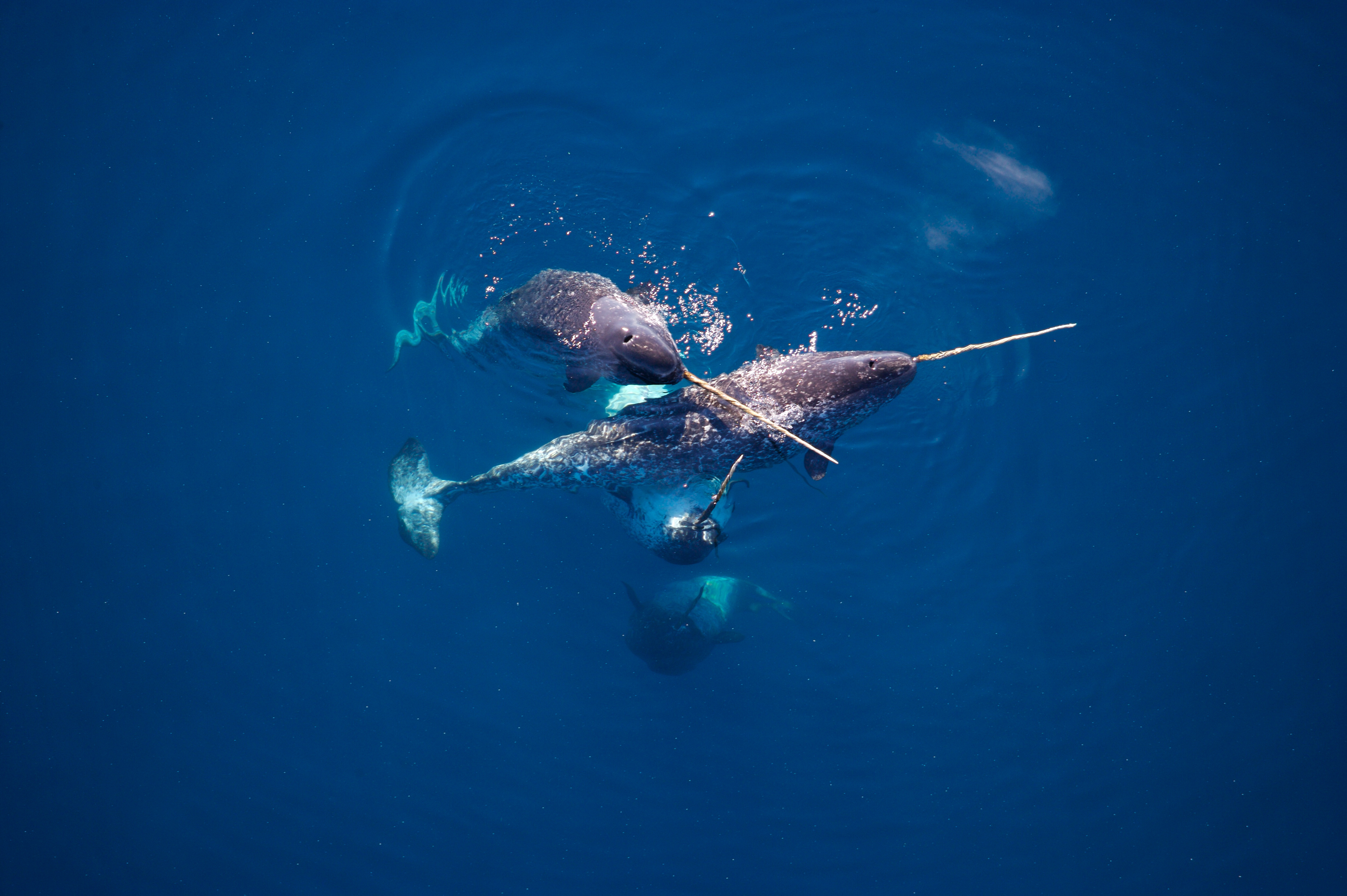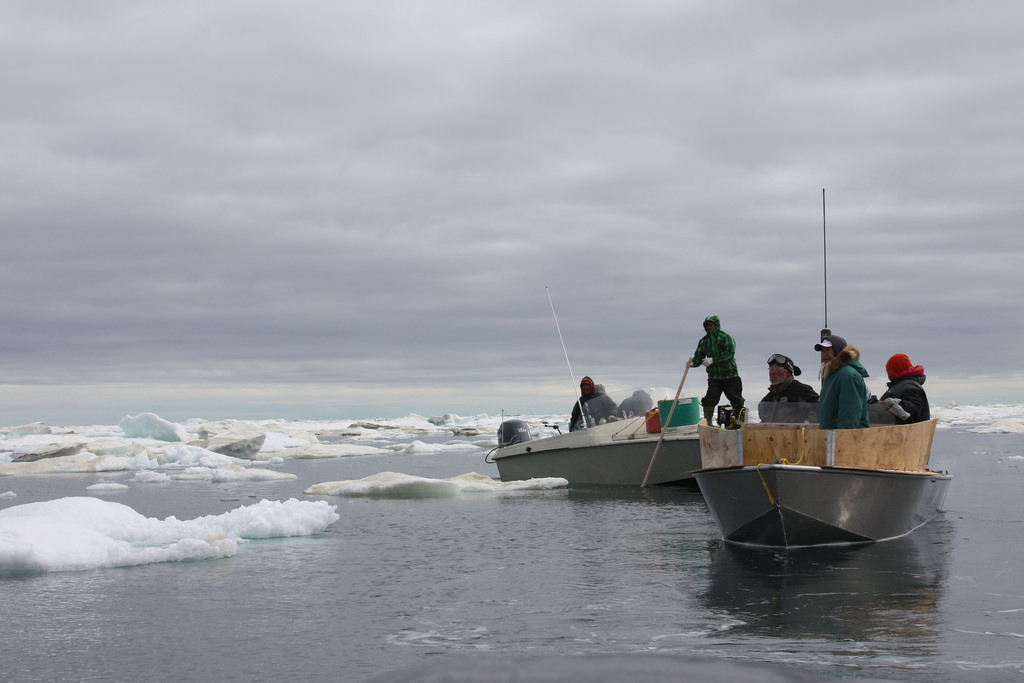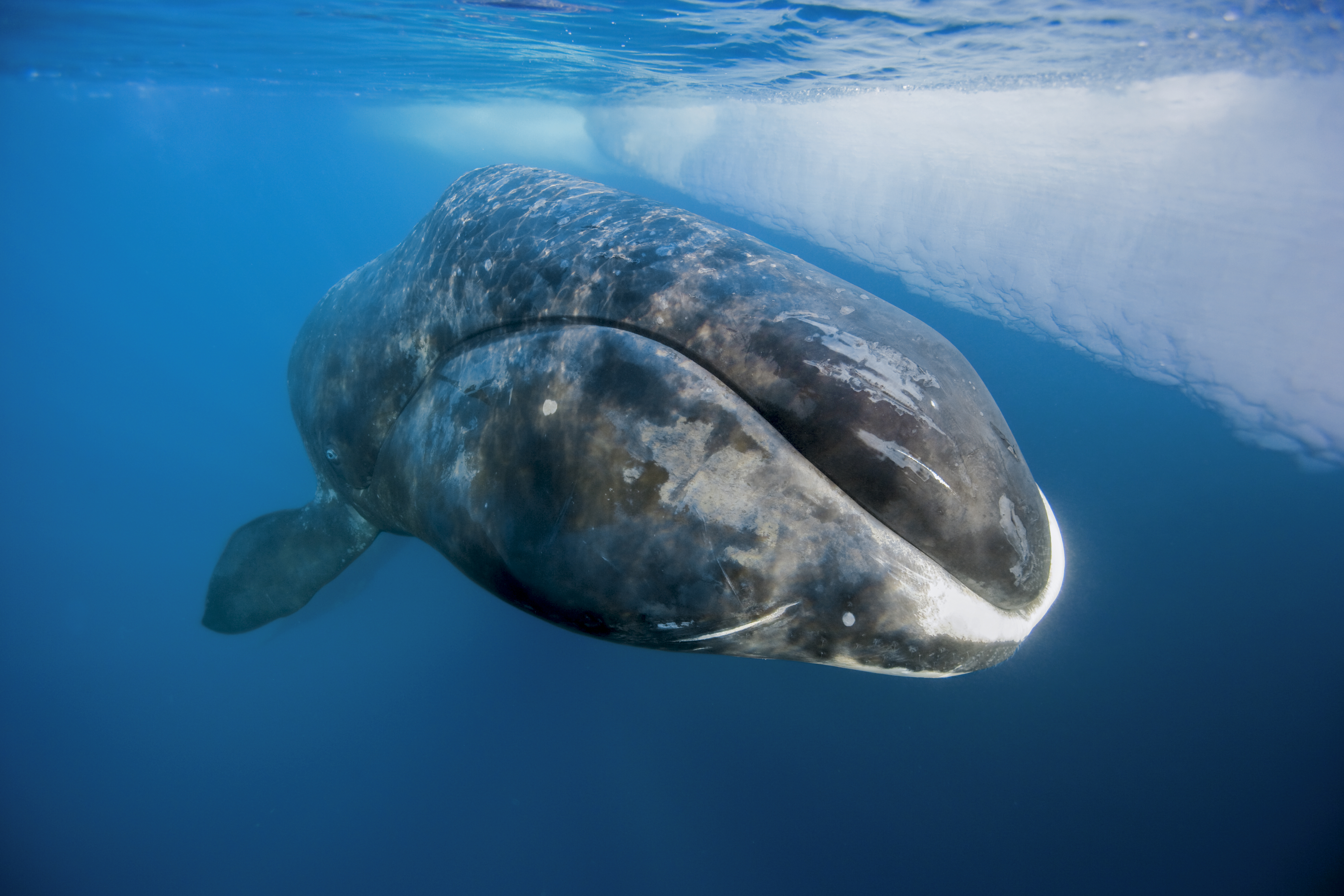The following article is part of an exhibit. Past exhibits are not updated.
The list of endangered animals in Canada is long:
456 as of 2013, over 40 per cent of which face imminent extinction.
While these animals make their home in every province and territory, some of the reasons for their decline — including climate change and habitat destruction — are easiest to observe in the Arctic. For example, scientists note that temperatures near the North Pole are rising twice as fast as the rest of the world, meaning sea ice — a crucial competent to Arctic ecosystems — is rapidly disappearing. Meanwhile, the Inuit are observing changes in animal migration patterns and population numbers, both of which affect their traditional hunting practices.
This exhibit highlights six of the animals struggling to adapt to changes in the Arctic: the polar bear, caribou, narwhal, bowhead whale, beluga and walrus. Images by internationally-renowned photographer Paul Nicklen introduce each of the animals, while excerpts from The Canadian Encyclopedia provide information on each species’ specific challenges. To complete the series, Yellowknife-based journalist Ashleigh Gaul pays tribute to the walrus hunt, making the connection between the loss of animal habitat and the loss of Inuit culture.
Narwhal

The narwhal's Canadian distribution is centered in Davis Strait, Baffin Bay, Lancaster Sound and the channels and fjords of the Arctic Archipelago, as well as in Hudson Strait, Repulse Bay and northern Hudson Bay. Rapidly changing sea ice conditions in the Arctic are regarded as a potentially serious threat to narwhals. Such change may lead to increased frequency of ice entrapment, leading to mass mortality from starvation, suffocation or predation. The reduction of sea ice also means increased human activity in the Arctic, as previously unnavigable areas become more accessible. As such, the narwhal’s habitat may become more threatened by oil development, commercial fishing and shipping.
Bowhead Whale

In Canada, the bowhead whale’s range includes eastern and western Arctic regions, in two populations. Both populations were severely reduced as a result of commercial whaling, which began in the 1500s and ended around 1915. Bowhead numbers have increased since they were first protected from commercial whaling in 1931. Today, these whales are affected by a range of human activities, including noise disturbance from shipping and offshore oil and gas development, injury or death from collisions with vessels, and entanglement in fishing gear. Reductions in sea ice due to climate change may result in greater exposure to human activities and may also provide killer whales with increased access to bowhead habitats, increasing predation.
Beluga Whale

Belugas are widely distributed in the Arctic and subarctic. Water contaminants are of greater concern for belugas in the St Lawrence than for belugas in the Arctic, as high concentrations of PCBs (i.e., man-made chemicals used in industry) have been found in this population. Belugas are also bound to be affected by climate change, although the nature and degree of the effects are uncertain and will probably vary across the various populations. Besides the ecological effects, reduced sea ice will lead to major changes in human activities, such as offshore oil, gas and hydroelectric development and commercial fishing, which can in turn have significant impacts on belugas and their habitat.
Polar Bear

The polar bear is the largest of the eight living species of bears. There are an estimated 20,000 to 25,000 polar bears worldwide, about 64 to 80 per cent of which are found in Canada — in the Yukon, Northwest Territories and Nunavut, as well as northern portions of Manitoba, Ontario, Québec and Newfoundland and Labrador. As a highly specialized species, the polar bear is dependent on sea ice and therefore particularly vulnerable to alteration of its environment. Changes in sea ice are already known to have resulted in decreased numbers and productivity of some subpopulations of polar bears, making loss of sea ice habitat the most critical conservation concern for these bears. Additional potential threats include oil exploration and development (such as in the Beaufort Sea), other resource exploration, icebreaking and shipping.
Caribou

Caribou in Canada are generally categorized into three types: peary, barren-ground and woodland. Key to the decline of the caribou is habitat loss and global warming. Warmer temperatures have allowed moose and deer to move further north, and since the abundance of predators depends on the abundance of their prey, wolves, cougars and coyotes are also expanding their ranges and increasing in population. Southern woodland caribou, unlike moose and deer, cannot coexist with such high predator numbers. For the peary and the barren-ground caribou, climate warming has resulted in an increase of ice and hard snow crusts on vegetation, leading to increased starvation. For the barren-ground, warmer temperatures affect migration patterns, as the sea ice used for travel is melting.
Walrus

There are two subspecies of walrus: Pacific walrus and Atlantic walrus. Only the Atlantic walrus occurs in Canada. Some researchers suggest the most significant threat to the Atlantic walrus is overhunting. Walrus hunting is open to both Inuit communities and sport hunters, despite being limited to the Inuit from 1928 to 1994. Sport-hunting licences are issued with the aim of benefiting northern communities. While hunting quotas exist in some areas, there is little research to show whether they are stringent enough to protect walrus populations. Data on the number of harvested walruses is limited, further complicating research. Other threats to the Atlantic walrus may include increased human activity, such as industrial development (e.g. mining) and ecotourism.
Remembering the Walrus Hunt
Scientists and Inuit agree that changes to the Arctic profoundly affect animal populations, which in turn profoundly affect Northern culture and tradition.
The Aivilingmiut of Nunavut are walrus hunters. Like many regional groups of Inuit, they’re named after the animal that once kept them alive. In all seasons, they follow the aivik (Inuktitut for walrus) north of Hudson Bay, all the way up to Baffin Island. These days, no one survives on walrus anymore; but still, when an Aivilingmiut elder broadcasts over the community radio that she’s craving igunaq —fermented walrus meat — local hunters have a duty to find it.
***
The boats shove off from a limestone shingle shore. It’s late July, and finally, Igloolik Bay is clear of ice. Each boat carries one family: mom, dad and one or two sons who’ve been chosen to learn the hunt. The loose itinerary says the Airuts, Ammaqs, Irngauts, and Awas will be gone for a week, and they’ve packed enough food and snacks to cover about three days. For the rest of that time, they’ll depend on the land: collecting rainwater from the tops of ice sheets, hunting ducks, and shooting seals when their black heads appear on the flat waves in the distance. They motor for hours, passing a hundred little islands. No one’s worried about running out of land.
Igloolik’s hunters and trappers instituted a moratorium on walrus tourism in 2008, banning sport hunting and photography trips south of Baffin Island. They said the increased traffic from tourists was scaring the animals eastward, toward Cape Dorset. Though the moratorium has since been lifted, some people think increased shipping and development on Baffin Island still stresses the walruses, while others say it’s the loss of sea ice. Whether the Atlantic herd is dying off or moving away is unknown, but locals say there are fewer around today than there were 30 years ago. Regardless, scientists and Inuit agree that changes to the Arctic profoundly affect animal populations, which in turn profoundly affect Northern culture and tradition.
***
By evening, the hunters make camp at an ancient walrus-hunting outpost, a small island, Qaisuut, just north of the northernmost tip of the Canadian mainland. In the 24-hour sunlight, no one sleeps. Hunter and father Lukie Airut cuts sealskin pelts into thin ropes, shaves the hair off, and dries them against an orange cliff. Elizabeth Awa teaches her granddaughters how to collect heather from the high, green fields and lays it down for a bed. Elder Abraham Uruyaralok sits on his mattress and sings traditional songs. He also monitors the high-frequency radio, chatting with other hunters in the area. The kids walk the thousand-year-old foot trails all night, in the purple light, with rifles. They’re guarding for polar bears. At a flat beach, they repeat the stories their parents told them; this island once teemed with walrus and hunters could pick them off from the land. In a sod house a little ways up from the beach, they find the remnants of ancient tools and kids games, and a human skull. The kids all know about the skull and visit it every time they come to Qaisuut. It’s a witness to what happens when too many hunts go bad and people are forced to change their way of life. All night, Peter Awa plays his fiddle, and boiled seal intestines circulate through the tents. They’re just passing time until morning.
Remembering the Walrus Hunt (continued)
The kids hold their knives and watch how the butchering goes. They will do this hunt after hunt, until they’re ready to try it out themselves.
The first herd we see we just watch. They’re like elephants in the water — clumsy. Even in the open ocean, they lumber and gasp, as if it’s difficult for them to keep their noses and mouths out of the water. Their heads bob up and down, tusks stabbing the waves. The six boats gather behind them, but the walruses don’t need to see us to know they’re in danger; they bob their heads a little faster; the herd splits. Awa shoots and hits a bull on the back of the neck. The bull rears back. Two boats rush to his side and pierce him with a homemade harpoon connected to an empty jerry can. He pounds at the jerry can with his tusks. He batters it but cannot puncture it. He rocks the twenty-foot aluminum boat with his thrashing.
Another shot from the boat next door and a cow is hit. Before the hunters can harpoon her, the rest of the herd has banded together around the female, and two others are carrying her away on their backs. An ice floe gets between the boat and the walruses, and Lukie Airut doesn’t think twice — he throws himself on top of the ice. For a moment, he stands with his harpoon poised over his head. When he learned to do this, he learned on a kayak. He throws his spear, but it bounces off her hide. He spears her again, this time through the left flipper. Airut jumps back on his boat and pulls her away from her herd with his sealskin rope. The boat, lopsided with the one-tonne weight, putters toward an ice pan about the size of a high school gym.
Nine walruses are culled from two herds in the morning, and then, all afternoon and into the evening, they’re butchered. It takes nine men and a pulley system to get each walrus out of the water. When fish-splitter knives open the grey, scarred hides, the ice fields turn red with blood. There’s no lunch break — livers and hearts are laid out in front of a lawn chair on the ice, and hunters can snack on them as they work. Each family butchers its own walrus, and each family works in its own way, but everyone’s preparing the same thing: the Aivilingmiut specialty, igunaq. They fold pouches of fat, meat and skin into airtight sacks, and sew the sacks closed with strings of extra skin from around the chest and rib cage. The kids hold their knives and watch how the butchering goes. They will do this hunt after hunt, until they’re ready to try it out themselves. Miss one year and they start to forget.
***
The boats are full, and the hunt is over; the kids are homesick anyway. The families split off when they get into shore, carrying their igunaq to rock caches just outside of town. The walrus meat, two men to a pouch, is carried to a burrow in the permafrost, where it sits to ferment for up to two years. Some Canada Day or birthday or whenever an elder gets on the radio with a craving for walrus, the hunters will dig it up and the town will remember that taste.

 Share on Facebook
Share on Facebook Share on X
Share on X Share by Email
Share by Email Share on Google Classroom
Share on Google Classroom












